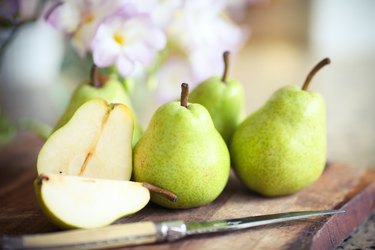
If you have diabetes, you know it's crucial to carefully monitor your diet. Consuming too many carbohydrates floods your body with glucose, causing your blood sugar to spike. But not all carbs are created equal, and it's possible to manage your diabetes and enjoy fruit like pears now and then.
Nutritional Benefits of Pears
Video of the Day
The good news is that most fresh fruits, including pears, are a healthy snack choice. Their natural sweetness will satisfy your craving for sweets, and they're packed with vitamins and minerals. Pears, though, also have a big benefit for people with diabetes.
Video of the Day
"Pears are high in fiber, which helps to prevent spikes in blood sugar, making them a good snack choice for diabetics," says Ashley Braun, RD, MPH, a dietitian based in Grand Rapids, Michigan.
Specifically, the Produce for Better Health Foundation reports that pears are packed with a soluble fiber called pectin. Soluble fiber can lower both blood sugar and cholesterol. This means that even though pears taste sweet, the pectin may help keep your sugar levels under control and reduce your risk for heart disease and colon cancer.
Snacking on pears gives your body a surge of vitamins and minerals. According to the U.S. Department of Agriculture, pears contain calcium, iron, magnesium and potassium as well as vitamins C, E and K. In a November 2015 review of studies on pears in Nutrition Today, a University of Minnesota team confirmed that a pear's skin holds most of its vitamin content, so wash the fruit and eat everything but the seeds to get the most nutritional value.
Pears are also naturally fat-free and sodium-free. According to the USDA, one small pear contains just 84 calories. That's substantial enough to curb cravings, yet light enough for those who are trying to lose weight or limit sugar.
Read more: Nutritional Content of Pears vs. Apples
Pears and the Glycemic Index
The Glycemic Index (GI) is a helpful tool for evaluating how quickly a food raises your blood sugar. The GI rates foods from 0 to 100, with 100 (pure glucose) indicating an immediate surge in blood sugar. In general, the lower the number, the safer a food is for people with diabetes.
David Perlmutter, MD, a Naples, Florida-based neurologist and medical author, says in his "Guide to the Glycemic Index" that foods with a GI under 55 are considered "low glycemic index foods." According to his guide, an average fresh pear has a GI score of 38, while a pear canned in pear juice has a GI score of 43.
According to the American Diabetes Association, "Most fruits have a low glycemic index (GI) because of their fructose and fiber content." Despite the sweet taste, the GI indicates that fresh fruit really is a healthy snack option, even for those with diabetes.
Pears vs. Other Sweets
If you crave a sweet treat, it's always better to reach for a piece of fruit than a packaged dessert or candy. That's because you're choosing a sweet snack that also includes vitamins and glucose-lowering fiber, instead of empty carbs.
Pears aren't your only nutritious fruit option. Research has looked specifically at the way pears and apples affect people with diabetes, with encouraging results. For instance, a study published in Food & Function in March 2017 that looked at people who were prediabetic found that eating apples and pears reduced their risk of developing type 2 diabetes by up to 18 percent.
If you have diabetes and want to add more pear-based snacks to your diet, Braun recommends pairing fruits with a healthy fat or lean protein. "A nut butter or Greek yogurt can leave you feeling full longer and [with] blood sugars more stable," she says. Try one of these healthy combinations:
- Baked pears with cinnamon
- Pear slices topped with a schmear of almond butter
- A whole pear served with a healthy fat such as a cheese stick or a dollop of cottage cheese
- Ashley Braun, RD, MPH, dietitian, Grand Rapids, Michigan
- American Diabetes Association: “Fruit”
- Produce for Better Health Foundation: “Pears … The Basics”
- David Perlmutter, MD: “Dr. Perlmutter’s Guide to the Glycemic Index”
- Nutrition Today: “Systemic Review of Pears and Health”
- Food & Function: “Apple and Pear Consumption and Type 2 Diabetes Mellitus Risk: a Meta-analysis of Prospective Cohort Studies”
- U.S. Department of Agriculture: “Pears, Raw”
Is this an emergency? If you are experiencing serious medical symptoms, please see the National Library of Medicine’s list of signs you need emergency medical attention or call 911.